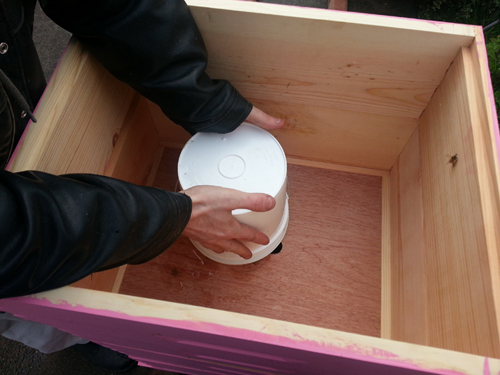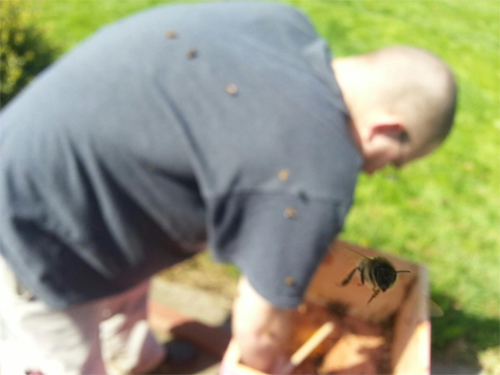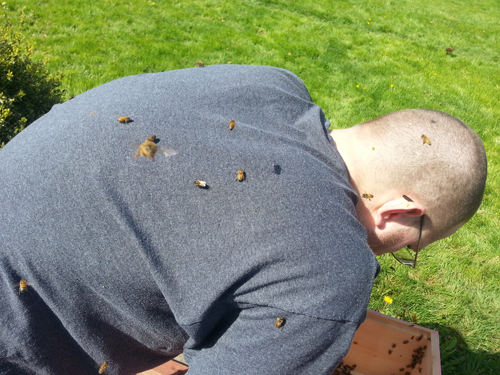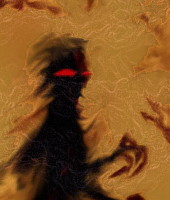Many of you expressed interest to know how our bee saga is going. Some of you know I've been painting hives like crazy and working on getting ready for them to come. We get our bees in two waves. The first wave came Saturday, in the form of a box of bees. These orders are called 'package bees' and they come in a mesh box with a tiny queen tucked up in her own little tiny wooden box. The rest of the workers love her smell and cling to her little travel box, remaining calm until they get to their destination.
So we picked them up on Saturday morning, early, in the cold and damp. These are California Italians so they aren't happy with the Pacific Northwest 50 degree cold. They are all clustered up keeping warm on the car ride home. Notice there are about a dozen cling-ons on the outside. They haven't realized they are out and not in.
This is me picking out our package.

This is me in the truck holding them on my lap.

So bees when they first start out have to build all their comb themselves. You have pre-waxed frames they build the comb within, but it takes time. They only need to build comb in one little section of the hive called the Deep Super. But we are doing whats called a soft release technique where we place an empty deep super on the hive stand, put the box of bees in it uncapped (after we remove the queen) and then let them wander out on their own. You take the queen and pull out the wax cork holding her prisoner in her tiny wooden box, then replace the cork with a marshmallow. Then you hang her tiny wooden box in among the waxed frames. The workers eat her out of her prison to release her... and then she gets on with her business of laying her eggs and whipping the hive into shape.
The Queen Cage... this is where the cork was... see the hole? You shove a mini marshmallow in there and the bees eat her free of her prison. You need the wire mesh there because Queens do nothing for themselves and on her trip she needed the wire so they could feed her and groom her on the trip.
So... I forgot to get pictures of the frames... though I will add some tomorrow when our second (phase two - the nuc)set of bees comes to our house and we add those bees to the next hive we have ready for them. So you can see...
Anyhow... so you have the frame stand, an empty super that has the box of bees in it, another super that has frames already hung in it with the queen suspended, then we put two honey supers in the top which are empty so they can conceal a bucket feeder we have upside down in the top. Its a gallon bucket (so its big) that's filled with sugar water and drips slowly into the hive to feed the bees until the nectar flow starts in the northwest. Nothing, absolutely nothing, is blooming right now so the bees would starve. And they need lots of food to draw out their comb and start their colony.
So this is what we get. Just a tiny part of this setup is where the actual bees are. You'll see later on what I mean.
Here's the breakdown. Top two sections are 'false' just concealing the bucket feeder. Later in the year they will have two sets of honey frames in there and be where the bees are storing honey hence the name 'honey super'.
The middle section is the actual hive, and the bottom box is yet another 'fake' or 'false' section concealing the box of bees that are slowly evacuating the travel box and moving upwards to join the queen.

Okay so we waited 24 hrs and let the bees get the queen free, her to bond with them, and them to settle in. Then we needed to tear the hive apart to remove the box of bees from the bottom and the unneeded deep super that concealed the box. Then we were able to take the two honey supers off and exchange it for the deep super we were using below to conceal the box of bees. Here's a peek inside at the bucket feeder I was telling you all about. And what happens when we removed it to break down the hive to check to see if the Queen was free and everyone was doing okay.
This is the feeder, an upside down bucket with a small mesh screen in the lid that drips sugar water..

Where is our food! Bring it back!

So that's what the bucket feeder looks like in the top and what it looks like when you take the bucket feeder away from hungry bees. BTW we weren't suited up to work with these critters. They were so calm and though they were flying around and hanging on us ab it, they weren't offering to sting or being upset at all.
Okay, so now you've seen this setup. WE let it hang out for 24 hrs and chill... get used to their new home, explore the property a bit, and generally fly around and be fun. If you noticed, doing this install we used no suits.. no smoke, no spray of sugar water. BTW good beekeepers don't use smoke anymore. They use sprays of sugar water. SMoking bees make them think they are in a fire and they gorge on food and move to take off from the hive and escape the fire. They get kinda stoned overeating and loose productivity for two days or so afterwards. So by spraying them with sugar water, they just settle down and groom each other. They don't get angry. They don't get shocked. And they get a delicious sugary snack. That's what the spray bottle is for in the first picture.
Now... we have to tear down the hive, remove the package bee box from the bottom, drop the hive down to the bottom of the frame stand, remove the sugar water mixture and then replace the feeder so we just have two small stacks. Here's some shots of that process and the end result. Remember the last hive shot is the finished hive... bees in the bottom, sugar water bucket hidden in the top section. In about thirty days I'll need to move sugar water feeder up another stack and add frames to the super that's hiding the feeding bucket atm, and let them expand even further. By then we'll have another generation of bees in the box that never made the trip from California but were born here in Washington.
I did suit up for the tearing down of the hive. Matt did not. No one got stung. They weren't even remotely upset. Here's some shots from that adventure.
My dog Mojo all curious about the buzzing. You can actually hear the hive buzzing and being busy.

Gillar bent over the hive moving things around. This is my favorite shot. The camera focused on the little bee headed my way, not on him.


They are just saying hi and getting to know him.

Gillar with bee brush in hand to gently move the critters around when he needs them out of the way. He's almost done. Can you see hes covered with bees? No one is stinging. This hive is very very gentle.

The final breakdown before we add another broodbox on the bottom in a months' time. It will look like this for a while. I have the almost empty package leaning against the entrance so the bees that are stragglers can get out and crawl into the hive.

And that's how you install a package of bees into a hive. I learned this on Mizahar doing threads for Kavala. I loved the idea of it so much I put it into practical use in my own life. Tonight Gillar gets to go pick up our nuc and I'll be able to show you pics of this and how they are installed into a hive. You'll see some frames then and what the actual hive covered with bees looks like.
I hope you enjoyed this scrap. It took me a while to get it together.




































